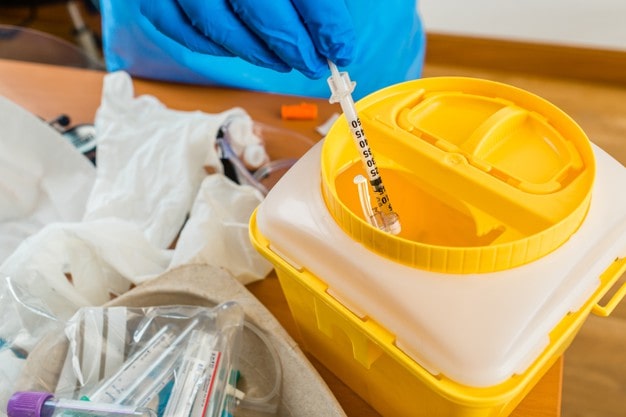MEDICAL WASTE COLLECTION
Medical waste collection has comprehensively named anything that comes into contact with body liquids. In particular, it is any strong collection that is created in the conclusion, treatment, or inoculation of people. This sort of waste need to be collected carefully in clinical settings and afterward with direct contact with the waste. The medical waste is gathered in exceptional packs and plastic boxes in various hospitals and clinics settings. In any case to mismanaging the medical waste collection, this cycle was immediately found to spread diseases, infections and conceivably cause episodes.
Biohazard Containers can safely contain used:
- Sharps
- Needles
- IV Catheters
Medical Waste may include includes:
- Paper towels or wipes contaminates
- Gloves used in procedures
- Syringes without needles
- Syringes with needles or sharp objects
- Bandages or dressings with small amounts of dry blood or fluid
- Any other material from medical care
Why Sharps/Needle collection Matters:

- As indicated by the NIH, appropriate sharps removal can stem the spread of irresistible blood-borne microorganisms.
- Data proposes that 16% of all word related wounds in medical clinics come from sharps.
- Sharps wounds boundlessly increment the danger to clinic laborers of sicknesses like Hepatitis B, Hepatitis C, and HIV.
- Appropriate sharps removal wipes out or enormously decreases the danger of sticks and contamination.
- Ill-advised sharps removal conveys strong fines.
Definition of Medical Waste Collection:
Medical waste is any kind of waste that contains infectious material (or material that’s potentially infectious). This definition includes waste generated by healthcare facilities like physician’s offices, hospitals, dental practices, laboratories, medical research facilities, and veterinary clinics. This includes:
- Anything that is soaked in blood (gloves, gauze, gowns, etc.)
- Human or animal tissues created during procedures
- Cultures of infectious diseases/agents
- Any waste produced in patient’s rooms with communicable diseases
- Discarded vaccines
Medical waste can contain bodily fluids like blood or other contaminants. The 1988 Medical Waste Tracking Act defined it as waste generated during medical research, testing, diagnosis, immunization, or treatment of either human beings or animals. Some examples are culture dishes, glassware, bandages, gloves, discarded sharps like needles or scalpels, swabs, and tissue.
- On-Site Medical Waste Collection
The on-site therapy medical collection is for the most part restricted to huge, well-monied emergency clinics and offices. on-site collection is incredibly cost-restrictive. That is on the grounds that the necessary gear is costly to purchase, costly to keep up, and costly to oversee and run. The administrative labyrinth around such hardware (and its utilization) presents one more boundary to the section.
- Off-Site Medical Waste collection
Off-site medical waste collection is undeniably more cost-effective for generally little and average-sized clinical practices and offices. Outsider Vendors whose primary business is medical care waste collection and removal have the gear and preparing expected to deal with the process. Vendors can gather the waste either by truck or via mail.
Best Practices for Medical Waste Collection
- Medical services laborers can dodge most clinical waste issues by clinging to a couple of key prescribed procedures. Workers should know the laws, at that point order and separate all loss by type into the right, shading coded medical waste containers. Waste ought to be marked relying upon its category, and the correct documentation ought to go with all containers during travel.
- Know the healthcare waste laws. Medical collection services are controlled by the DOT, EPA, OSHA, and the DEA. It’s imperative to know about all rules from every organization while planning, moving, and discarding unsafe waste.
- Classify medical collection correctly. Distinguishing the sort of collection you’re managing is the initial phase inappropriately collecting it. Try not to put non-perilous waste in with the rest to forestall overspending.
- Separate the collection by type. Collection ought to be isolated out into the various classifications, including sharps, drug, synthetic, neurotic, and non-dangerous. The controlled medical collection goes in red sacks. Sharps that go into these sacks should be placed into puncture-proof containers first.
- Use the right medical waste containers. Put all medical Waste collection in correct and appropriate container relying upon how it’s classified. Some collection can go in guaranteed cardboard boxes, while other collection gets placed in uncommon tubs or even secured for travel.
